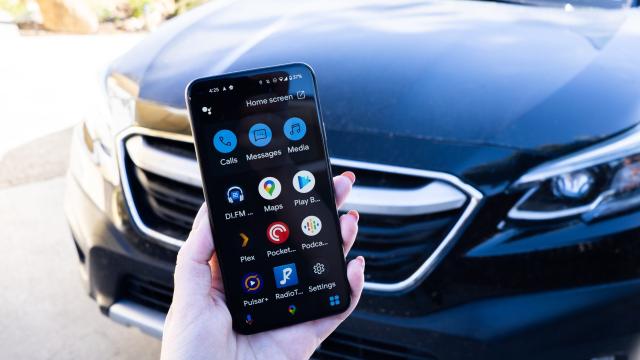I live in the California suburbs, known for their relative un-walkability, exacerbated by the presence of rolling hills and sweltering hot days. I rely on my car to get me and my family places, and I want the least distraction possible when I’m behind the wheel.
I adopted Android Auto back in 2016 as my ageing car’s in-dash entertainment system when Google phone-only version of Android Auto for vehicles without infotainment systems. Eventually, manufacturers like Anker started making third-party adapters like the Roav Bolt, which plug into a car outlet and broadcast audio through the vehicle’s speakers via Bluetooth. It was a way for me to cheat out of upgrading my car to get hands-free features.
But Google plans to do away with the Android Auto standalone phone app and is instead pivoting to a more streamlined experience inside the Google Maps app. It’s called Assistant Driving Mode, and it’s started rolling out to select devices, according to 9to5Google. If you’re running the Android 12 Beta, you should see it pop up once you shout out, “Start driving mode” or, “Let’s drive” to the Google Assistant. Some have also reported it popping up on Android 11 devices running the Google Assistant beta, which you can flip on through the Play Store, though I couldn’t get it to come up myself.
I did manage to get it to work on the Pixel 5 with the latest Android 12 beta update. There’s a support page if you need more help getting it to show up. The new UI is supposed to be available without entering a destination, but I was only able to get the new home screen the first time I asked the Assistant to launch the feature, after which it realised I wasn’t driving anywhere and reverted to Google Maps. The bottom right-hand corner of the Maps app displays a little app drawer button like you’d see on Android, and pressing that takes you to a driving launcher of sorts.

You can choose your apps from here, similar to the way you’d browse through apps in the Android Auto launcher on cars that have it embedded in the dash. Each little app has an interface that populates with quick links and playlists if it’s a media playback app. There are also quick buttons to make a call, send and view messages, or look through media playlists curated for you by the Assistant in apps like YouTube Music and Google Podcasts — two apps I don’t use at all. I even marked Spotify as my default music player in the Google Assistant settings, but I don’t have access to those playlists unless I specifically tap into the Spotify app.
There is no back button on Assistant Driving Mode, so if you want to move on to another task or another app, you’ll have to tap the launcher and select the option that suits you. Or you can utter the, “Hey Google” command, which is what this feature is supposed to inspire you to do, anyway. It’s why you’d buy an accessory like the Roav Bolt, which adds a microphone to your car so it can hear you say it, and why Google is shifting away from the original look of Android Auto on the phone.

The new Assistant Driving Mode isn’t perfect, but it feels like a step in the right direction. It’s much better than the initial preview I saw at Google I/O in 2019, where I saw a demonstration of a full-page interface that long-scrolled through each of the feature options available while driving. The interface is also much easier to tap through with one finger, and there are fewer menus to deal with, probably why there’s no longer a “back” button to drag you through menu structures. The key to a safe in-car interface is that you can glance at it to get the information you need without taking your focus off the road (which is why I try to avoid driving on beta software!).
I hope it will become a little easier to get to the curated home screen without entering navigation mode or the car having to recognise motion. After all, what if I’m driving nowhere in particular, but I still want to shuffle through my music? I can access the Assistant Driving Mode to start the song, but only if I set up a destination, which I don’t always need to do.
With the Android Auto phone app heading to the Google Graveyard soon, it’s nice to see that Google is trying to improve the Assistant Driving Mode. It makes it easier for those of us without Android Auto-compatible cars to have features and apps that are optimised for safer driving.
